
Amazon Competitor Analysis: How to Leverage Market Insights to Outperform the Competition
Martin Saunders, March 14, 2023
Table of Contents
Amazon competitor analysis has become essential for brands and sellers that want to outmaneuver the competition. The hyper-competitive nature of Amazon combined with the long-standing focus on user-centered data has provided an opportunity for market-aware advertisers—i.e., those that know and learn from their competition—to grow sales, increase market share, and increase the impact of ad spend.
Before we explain what market-aware advertising is and how you can conduct an Amazon competitor analysis, let’s quickly review how we got here. Broadly speaking, we can divide the history of Amazon advertising into three stages:
Stage 1: The Early Days
Stage 2: The Era of User-Centered Development
Stage 3: The Era of Market Awareness.
The old hands in our audience will remember that in the “The Early Days” advertisers had access only to Sponsored Products ads and eight weeks of performance data. Running ads was easy, it was cheap, and most advertisers saw success. This success led to more investment in Amazon ads, and to the next stage of the platform’s evolution.
Today, we find ourselves at the end of the second stage, “The Era of User-Centered Development.” During this phase, advertising on Amazon has developed a lot, with multiple ad types, sophisticated targeting, and proprietary reporting that allows sellers to understand how different ad types interact and work together (think AMC).
While Amazon advertisers on Amazon will almost certainly continue to have access to greater data and capabilities, the third phase of Amazon advertising, “The Era of Market-Awareness,” will be defined by a widening of advertisers’ focus to include the performance data of their competitors and the market around them.
Below is an outline of the topics we’ll cover in this post. First, we’ll explain how you can become market aware by analyzing your competitors on Amazon. Then we’ll discuss how you can leverage insights about the market to outperform the competition.
Top sellers use cutting-edge advertising tools
Perpetua offers the most advanced Amazon PPC solution on the market, with all the tools, resources, and expert support you need to build successful campaigns for your products. And what’s more, it couldn’t be easier to get started. Request a free demo today to discover the industry’s premier optimization and intelligence software for Amazon Ads.
What is an Amazon competitor analysis?
An Amazon competitor analysis is the process of defining, identifying, and understanding the products on Amazon that compete with your product portfolio. This information can then be used to improve your product positioning, listings, and advertising to take sales from your competitors.
Why should I analyze my competition on Amazon?
Amazon is one of the most competitive environments in e-commerce. From the search results page to product detail pages and advertising placements, your product is always surrounded by competing products. There is almost never a time when a shopper will see only your product.
(The one exception to this is the Brand Store. But even the Brand Store eventually sends shoppers to product detail pages, where they will see competing products again.)
“When competition is always just one click away, your competition will have a significant impact on your performance.”
For example, let’s say you sell drills and that your product is always high in the organic rankings, but hasn’t yet become the best seller. If the best seller goes out of stock, your product is going to see a boost in sales without any action on your part. Similarly, if the best seller starts advertising on your product detail page, you are likely to see a drop in revenue. Again, through no action on your part.
To win in today’s environment, advertisers need to:
understand what is happening in the larger market around them, and
use this information to optimize their advertising.
How can I conduct an Amazon competitor analysis?
In order to conduct an Amazon competitor analysis, you will first need to define what your market is. While this sounds straightforward, defining your market requires a good understanding of the product and your industry, and some rigorous thinking. Below we share a framework that advertisers can use to begin building their market.
Define your market
The “right market” is a group of ASINs that generates high relative sales volume and addresses the same shopper intent as your product(s).
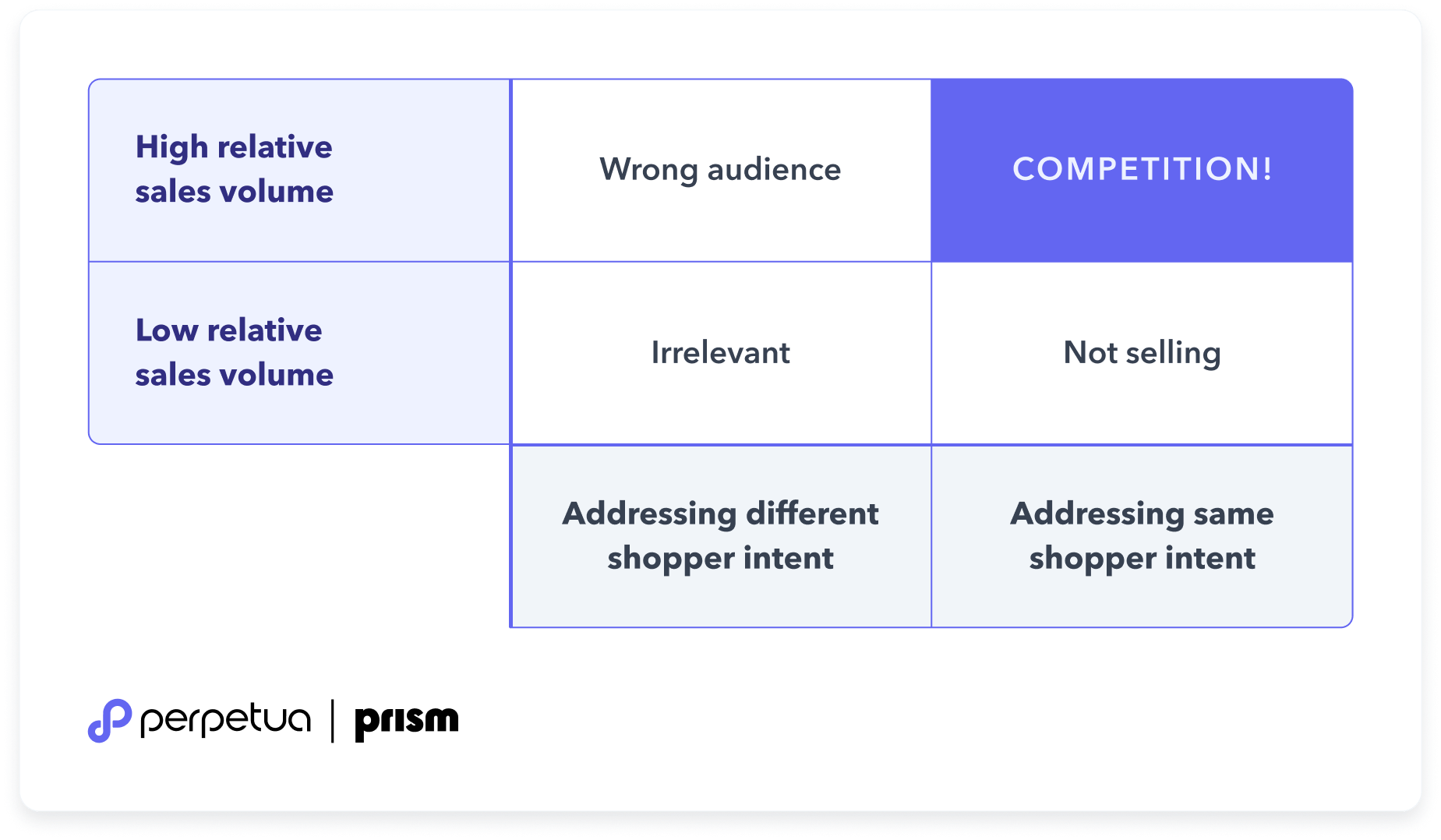
Identify the “right” shopper intent
To identify competitor products that have the “right” shopper intent, the traditional approach has been to identify ASINs based on product categories. However, there are several challenges with this approach:
ASINs are often miscategorized;
categories frequently change;
categories are sometimes too broad or too narrow.
Top sellers use cutting-edge advertising tools
Perpetua offers the most advanced Amazon PPC solution on the market, with all the tools, resources, and expert support you need to build successful campaigns for your products. And what’s more, it couldn’t be easier to get started. Request a free demo today to discover the industry’s premier optimization and intelligence software for Amazon Ads.
Our recommended approach is to identify ASINs based on keyword rankings and/or product title. Why? Shoppers express their needs quite clearly in their search queries. And Amazon has invested a lot of money in developing an algorithm to meet the needs that shoppers express through these queries.
Therefore, if different ASINs rank for a search term, it’s because shoppers are buying those products after including that search term in their query. In most cases, this means that the ASINs address the same shopper need.
For example, take baby carriers and baby slings. Technically they are different products, but they address the same customer intent: buying a product that will help carry around a baby.
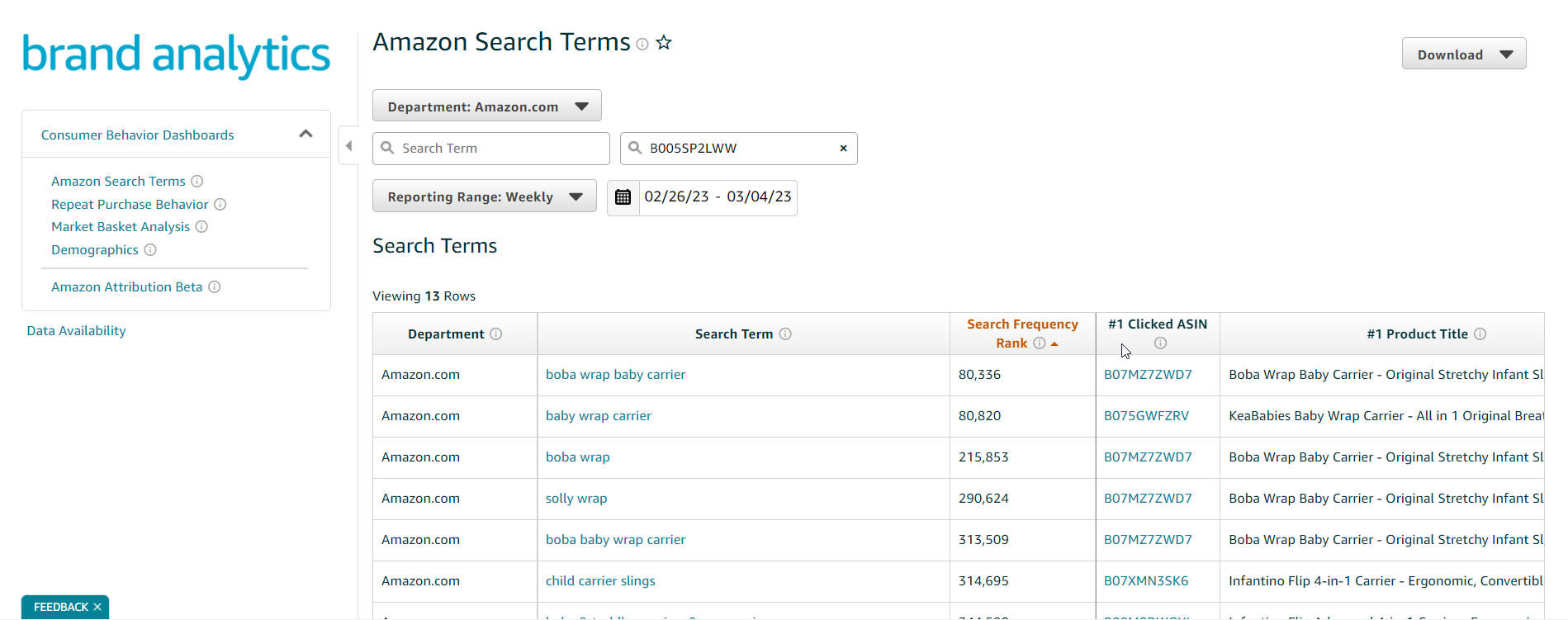
One of the easiest ways to identify ASINs that rank for the same search terms is to:
go to seller central and navigate to the Amazon Search Term report in Brand Analytics
enter the ASIN(s) you’re defining a market for
navigate to the “Download” menu in the upper-right-hand corner and export all ASINs.
Now you have a list of relevant competitors.
Note that this approach limits your results to the three highest-ranking ASINs for each search term in the Amazon Search Term report. Nonetheless, it’s an easy and fast way to get started. To go deeper, you’ll need an Amazon competitor analysis tool. We’ll cover this later in the article.
Estimate sales for products addressing the same shopper intent
One way to get rough sales estimates for relevant competitor products is to plot the best seller rank (BSR) of your products against their sales data. You can then use the trendline to get an idea of how well or poorly your competitors’ products are selling. Note that this approach will only work for products in the same category or subcategory, as sales vary widely across categories and subcategories.
A bit of background for those who are unfamiliar with BSR. Every ASIN on Amazon has a “Best Seller Rank.” The BSR puts all ASINs in a hierarchy based on units sold within a product category and a certain time frame. So for example, the ASIN with BSR 1 is the best-selling ASIN in that category, BSR 2 is the second-best selling, and so on.

If you’re selling on Amazon, you will have sales data for your items. You can look up the BSR for your products and plot BSR and sales on a chart like the one below. These can serve as reference points. You can then draw a trendline and approximate the sales for ASINs that you have included in your market. This is a way to get to rough sales estimates quickly.
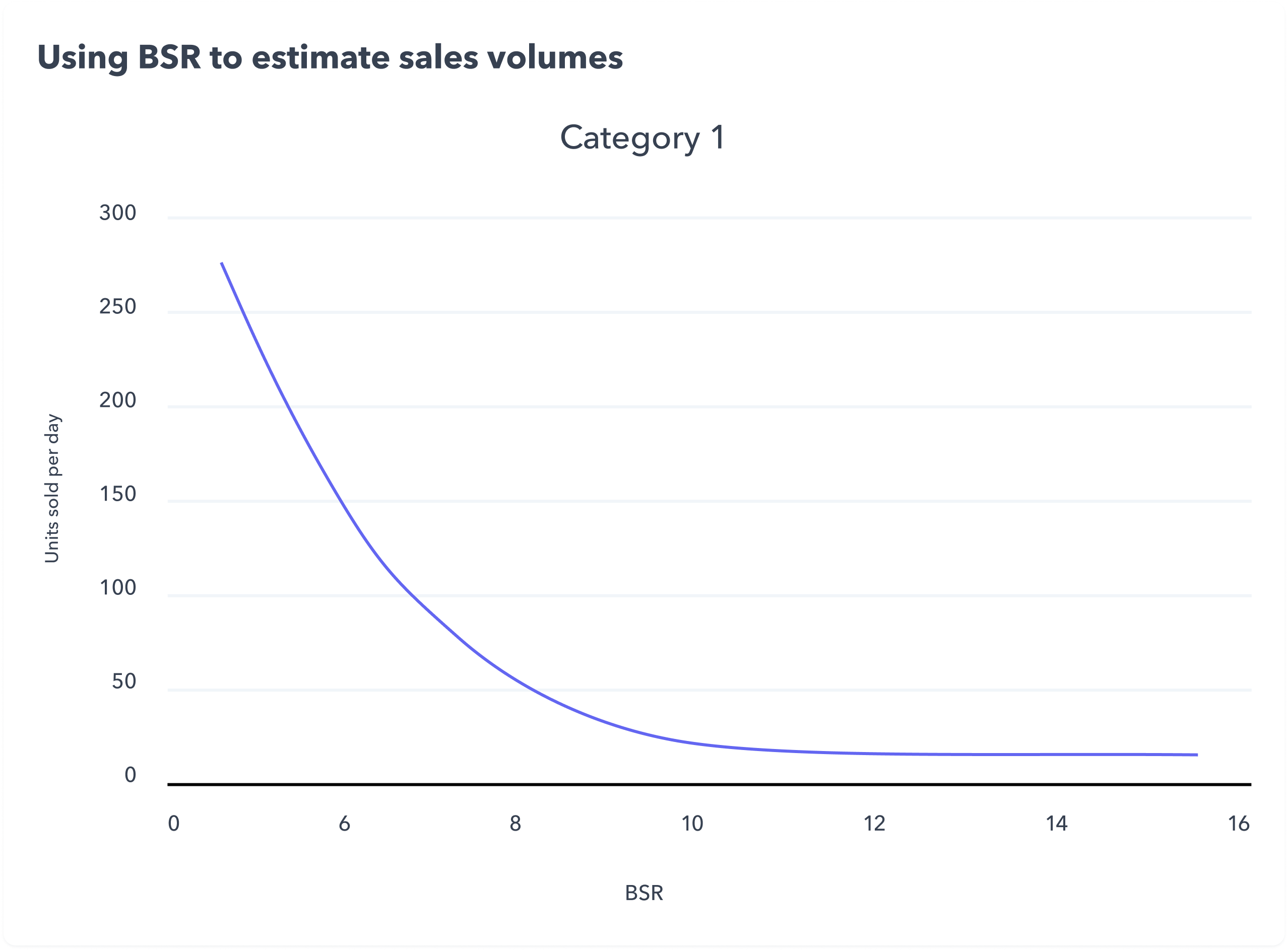
While it’s easy to get a broad idea of sales volume for competitor products, arriving at more precise numbers is much more difficult. A number of complex questions need to be addressed. For example, how do you account for the fact that the BSR is updated every couple of hours? How much are historical sales weighed in your BSR? What if you are not the only one who sells your ASIN? And how do you differentiate between an ASIN that’s gone out of stock and an ASIN that’s simply dropping in popularity?
These are all complexities that an Amazon competitor analysis tool can help to address.
Determine the right size for your market
The final step in conducting your Amazon competitor analysis is determining the right size of your market. Brands will typically create two types of markets: one for tactical decisions and one for strategic analysis.
Tactical Decisions | - 5-20 direct competitor ASINs - too many ASINs will lead to noise - noisy data = difficult to action |
|---|---|
Strategic Analysis | - broader markets with hundreds to tens of thousands of ASINs - more manageable with Amazon competitive intelligence tools |
For tactical decisions, it’s normally enough to take between 5-20 of your top competitors into account. The reason for this is if you include too many competitors, you’re likely to get noisy data. This will lead to contradictory signals, making it difficult to interpret and act on the information you’ve collected.
For strategic analysis, you should use as many relevant competitors as possible. The challenge is that executing these analyses can be difficult to carry out unless you (or someone you employ) have advanced data analysis capabilities. This is where an Amazon competitive intelligence tool will come in handy.
Top sellers use cutting-edge advertising tools
Perpetua offers the most advanced Amazon PPC solution on the market, with all the tools, resources, and expert support you need to build successful campaigns for your products. And what’s more, it couldn’t be easier to get started. Request a free demo today to discover the industry’s premier optimization and intelligence software for Amazon Ads.
Prism: driving success on Amazon with market and competitive data
Today, two obstacles stand between advertisers and actioning the market intelligence that can give them an edge: 1) the manual research needed to understand the market is often too time-consuming; and 2) there are limitations around the data that brands, agencies, and aggregators have access to.
Prism, Perpetua’s fully-integrated competitive intelligence solution, bridges the gap between the needs of Amazon sellers and the demands of a hyper-competitive marketplace. With Prism, advertisers can include market and competitive dynamics when setting an advertising strategy, optimizing ads, and reporting on ad performance. Below we highlight four use cases that illustrate how market awareness can help you beat the competition.
Use case 1: quickly identify and target top competitor ASINs
With Prism you can create custom markets, defining your desired market as broadly or specifically as you want based on a range of factors like keywords, category, brand, average price, weekly estimated sales, average ratings, and average reviews. Once you’ve made your market segment, you can quickly see the top-selling competitor ASINs.
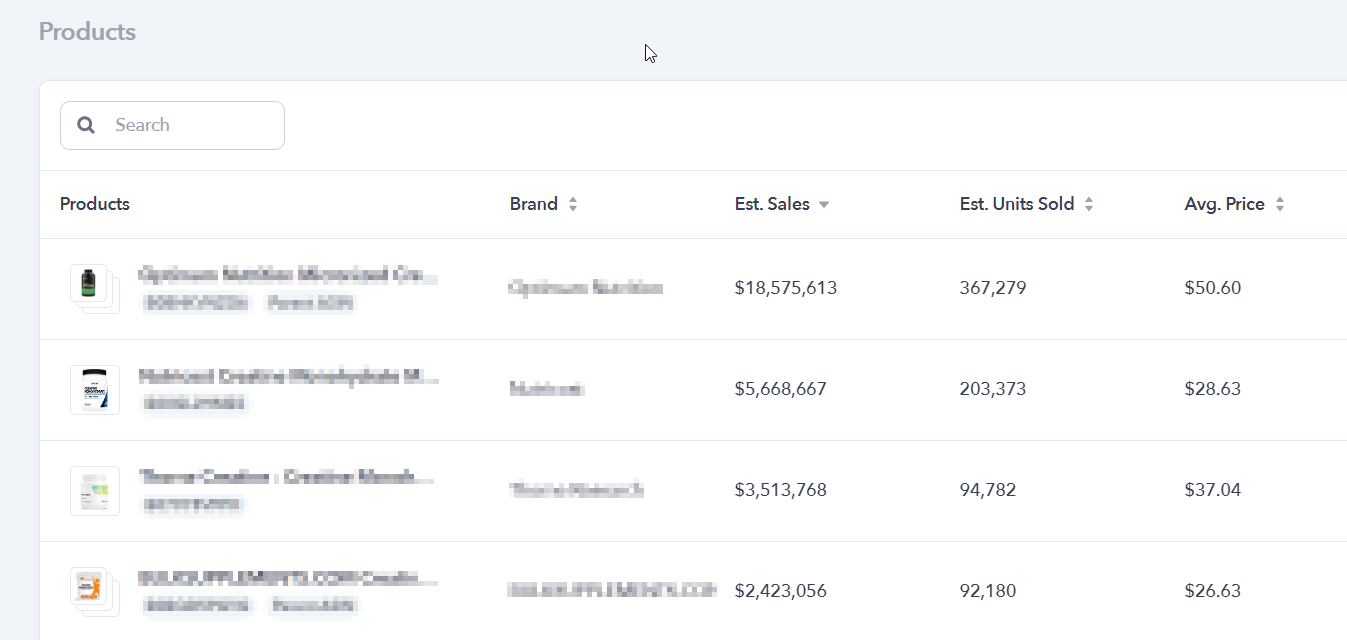
Once you’ve identified the best-selling products in your market, you can create advertising campaigns in Perpetua that target them. Using ASIN targeting with Sponsored Products ads is often a very cost-effective way of targeting competitor products. Another option is Sponsored Display ads.
Sponsored Display campaigns are an especially powerful tool when targeting competitor ASINs because they offer above-the-fold placements on competitor product detail pages that link to your advertised product’s product detail page. You can also use Sponsored Display ads to target shoppers who have viewed your product detail pages or competitor product detail pages through views remarketing. Both strategies offer effective ways to divert sales from the competition.
For more on how to use Sponsored Display ads to target top competitor products, check out our guide to Sponsored Display ads.
Use case 2: boosting keywords where competitors outrank you
Next, you can compare your organic rankings with the organic rankings of competitors and specifically go after the keywords where a competitor is outranking you. Prism shows you:
the top search terms for the market you’ve defined
the search rank frequency (SRF) for each search term
your and your competitors’ standing in Amazon’s organic rankings
and the percentage of shopper searches your ASIN did not show up in the top of search ad placements.
Armed with this information, you can easily identify opportunities to double down on targeting high-impact keywords. Especially those you aren’t ranking highly for, but that your competitors are, and those where your ASIN is not appearing in the top of search ad placements. If you’re a Perpetua user, you can use the keyword boost functionality to increase your bids on the desired keywords and dominate top-of-search to drive your products’ organic rankings higher.
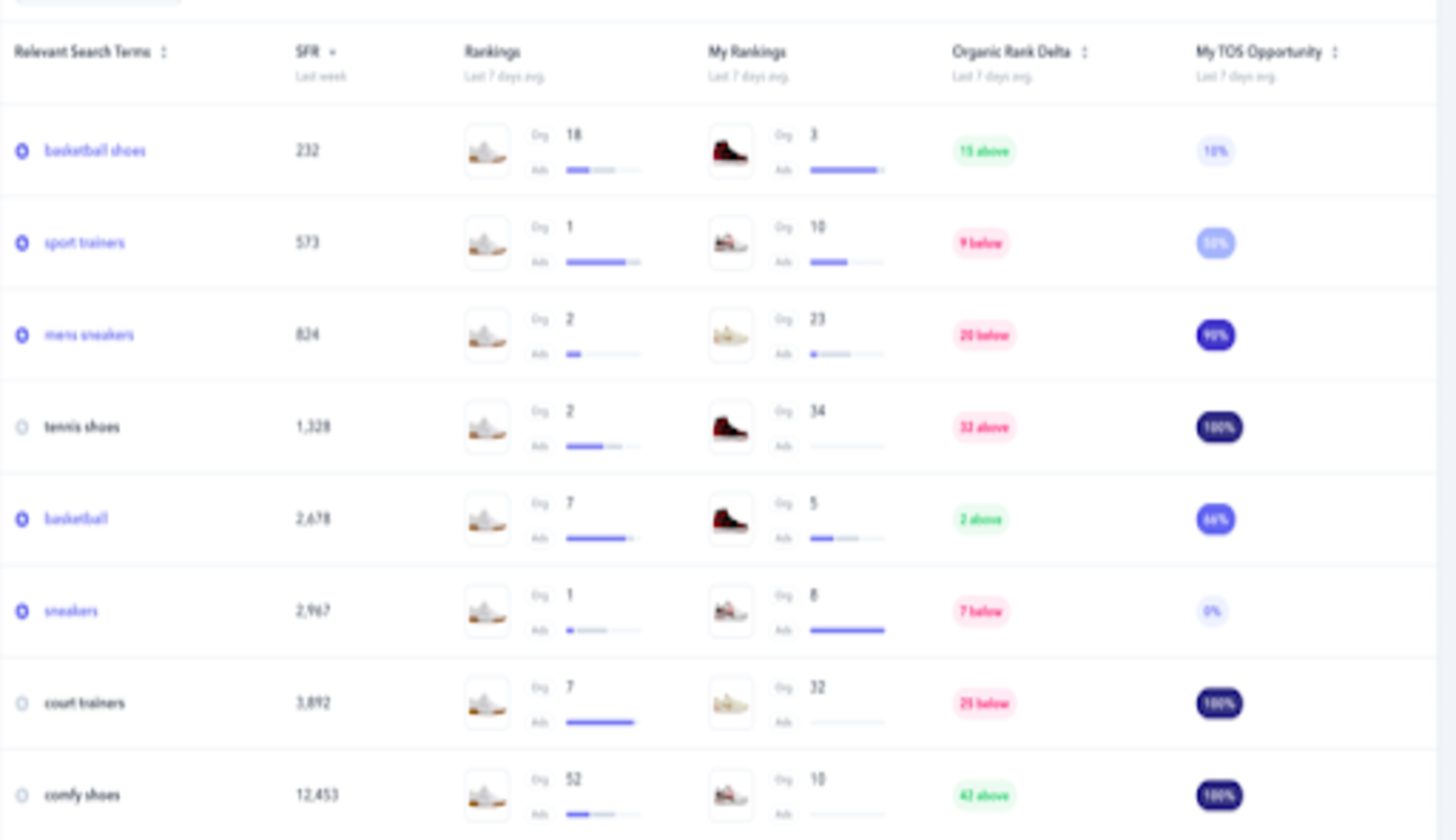
When you "boost a keyword" in Perpetua, that keyword will be put into a single keyword campaign with a top-of-search multiplier. You can then choose the percentage increments (Auto, 50%, 100%, 150%, and 200%) that will be applied in the Top of Search Multiplier. To read more about how bid multipliers work, check out this article.
Using bid multipliers is one of the most powerful ways to improve your product’s organic ranking for flagship keywords. By directing more ad spend towards the top of search ad placements for those essential keywords, more sales will be generated when customers type in matching search queries. This signals to Amazon’s algorithm that your product should appear higher in the organic rankings for customer search queries that match the keywords you’ve targeted with your keyword boost.
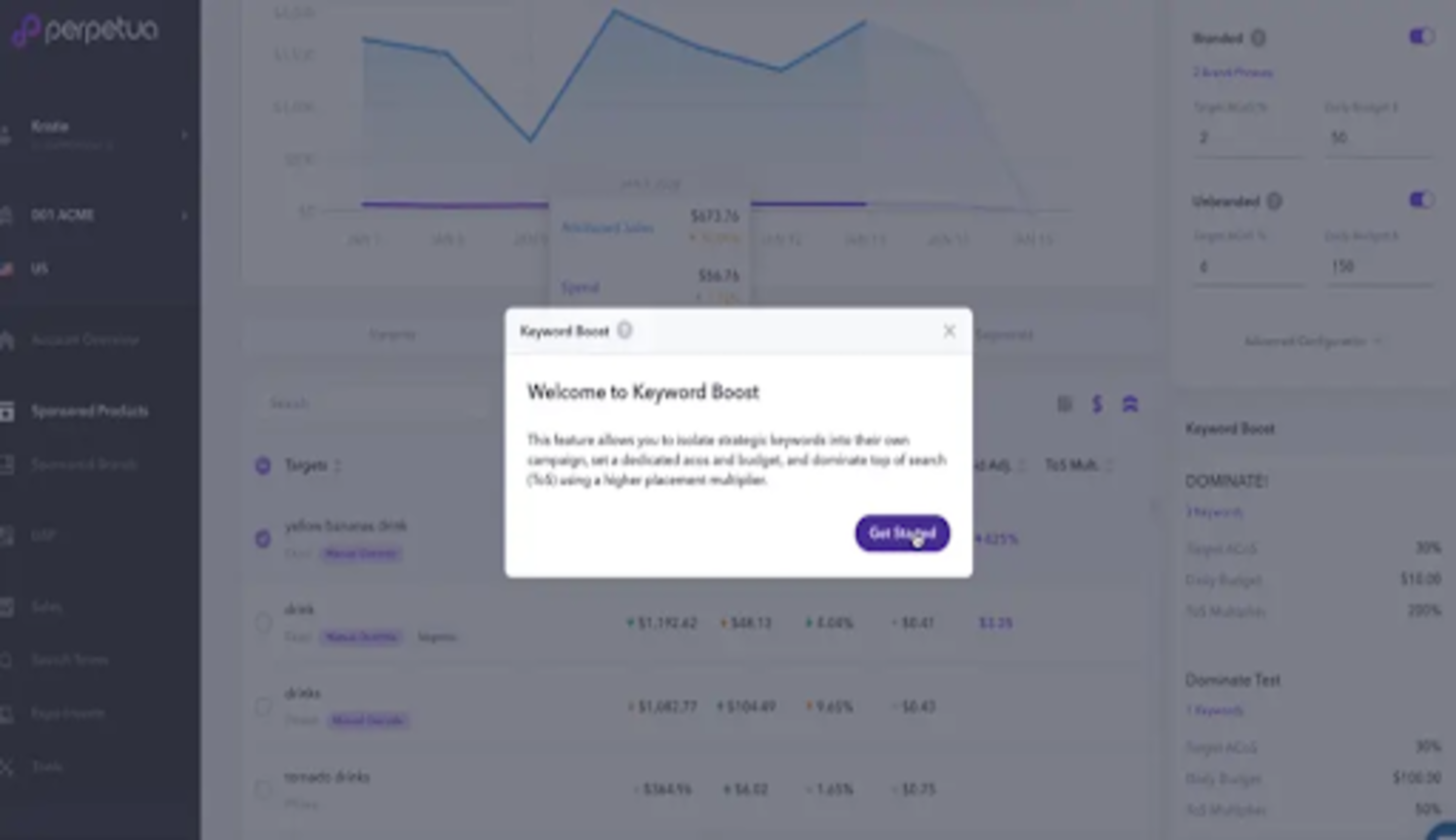
So the goal of keyword boost is to strengthen your organic ranking and boost organic sales (and therefore, profits). But be aware that using this strategy involves more ad spend and a less-efficient ACOS in the short term. The goal is not efficiency: keyword boost increases short-term cost in the interest of long-term gain.
Top sellers use cutting-edge advertising tools
Perpetua offers the most advanced Amazon PPC solution on the market, with all the tools, resources, and expert support you need to build successful campaigns for your products. And what’s more, it couldn’t be easier to get started. Request a free demo today to discover the industry’s premier optimization and intelligence software for Amazon Ads.
Use case 3: assess the impact of advertising on market share
Understanding market share gives advertisers a powerful tool to assess general performance and to report progress to stakeholders. By tracking market share over time, you can track the impact of your ad spend and better understand if you are reaching your goals.
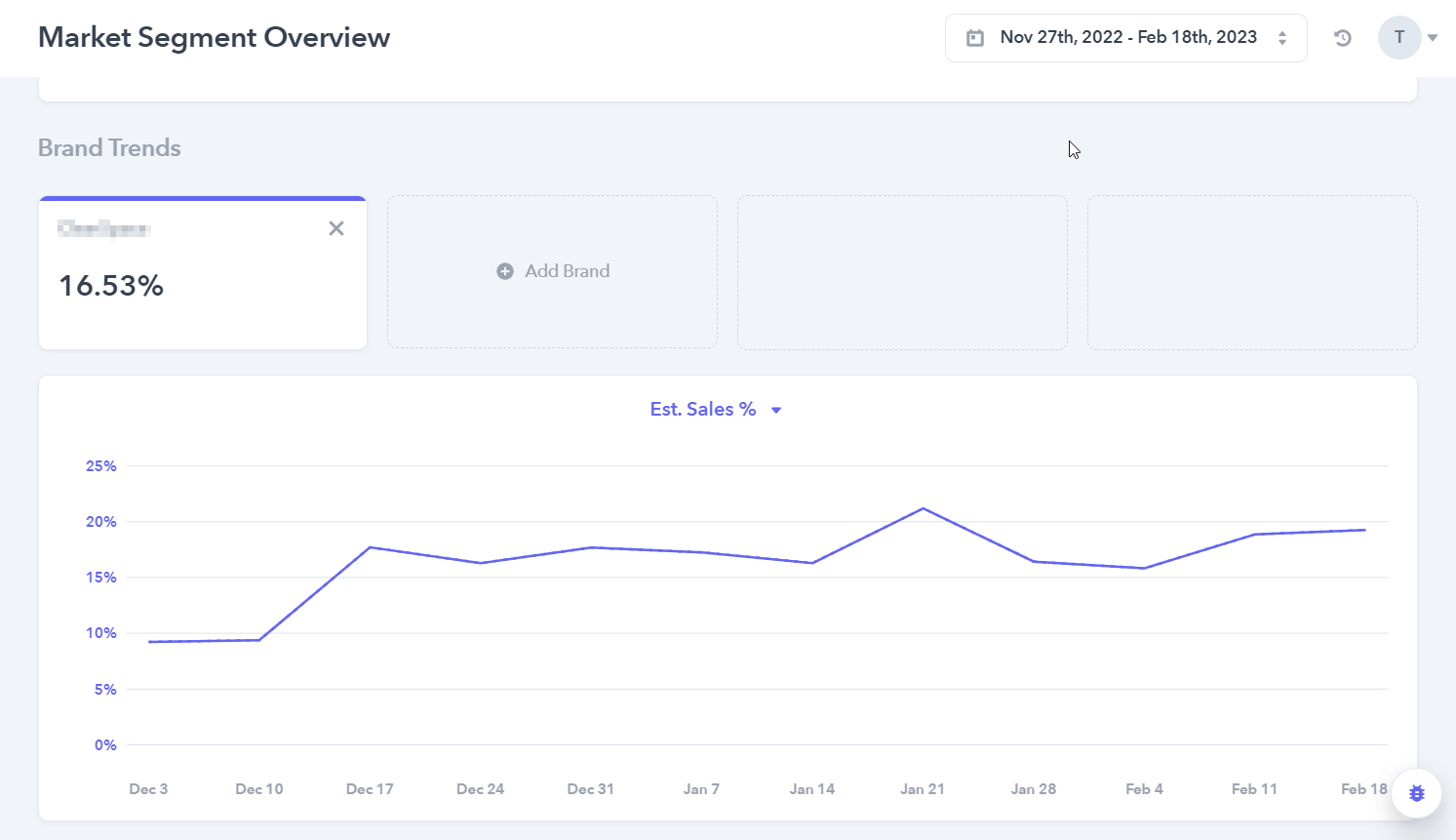
Every advertiser knows it’s essential to set a target ACOS that’s aligned with their goals. What every advertiser doesn’t know is how their market share will change if they increase (or decrease) their target ACOS. Prism can answer that question.
When you define a market segment in Prism, you can see how your share of that market evolves over time and in relation to your target ACOS. For example, if you increase your target ACOS from 20% to 25%, you can see how much market share you’ve gained, and if the investment is worth it. The same thing holds true for budget decisions. By tracking your market share with Prism, you can understand how your overall level of investment in advertising impacts your market share. And you can have clear data to communicate the outcomes of this investment to relevant stakeholders.
For more on how you can use Prism's data, check out our study of the "Patio, Lawn, and Garden" and the "Health and Household" categories.
Use case 4: track overall market growth and seasonalities to set appropriate ad budgets
If you have a well-defined market and you track how it is evolving, you can see seasonalities. This information can be used to identify and capitalize on opportunities.
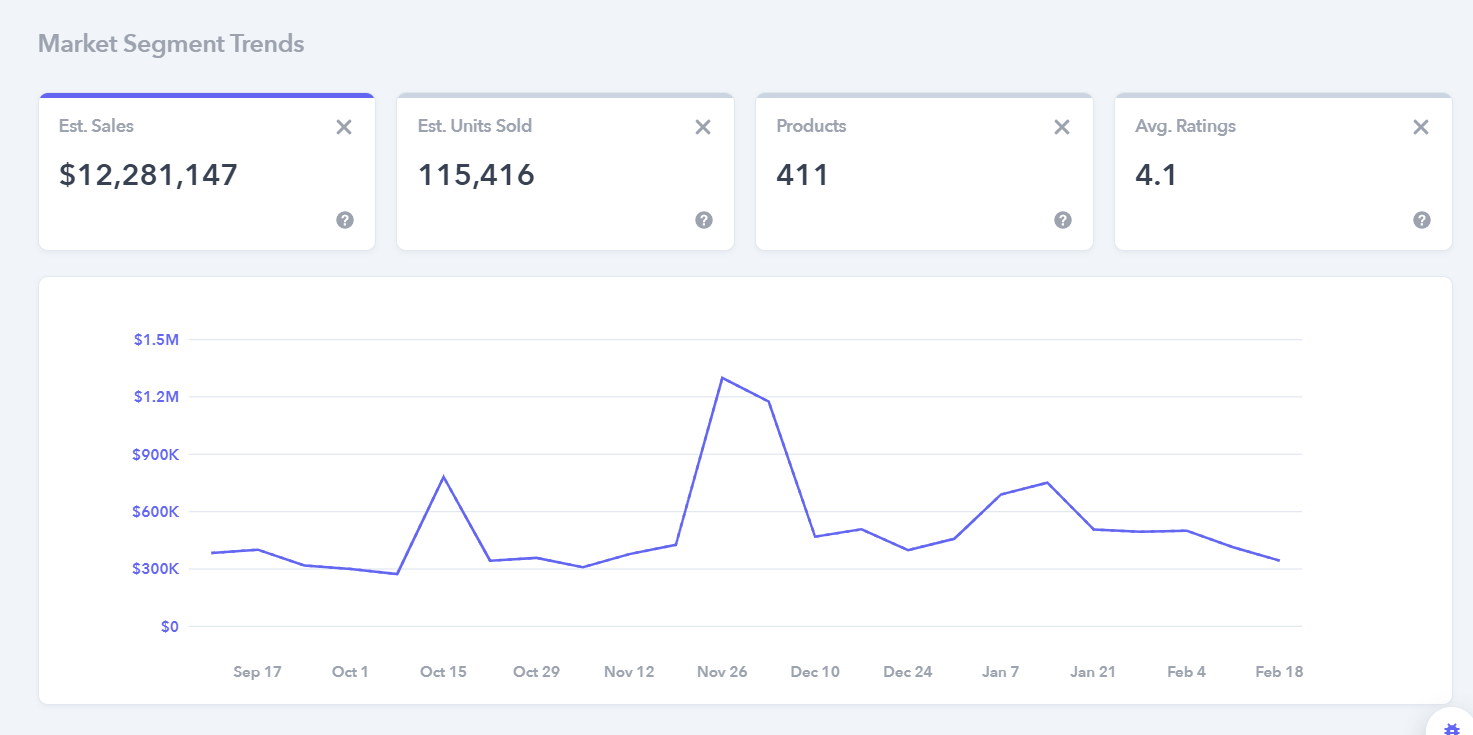
Above is a real example of a market segment for digital body scales built using Prism. The chart shows that sales peak around Prime Day which (was in October) and around Black Friday/Cyber Monday (BFCM), after which sales go down.
But after Christmas, we see that sales go up again reaching levels similar to those seen during the Prime Day peak period. Why? One likely explanation is that after the holidays people look to improve their health (and weight) in the new year. New year, new you.
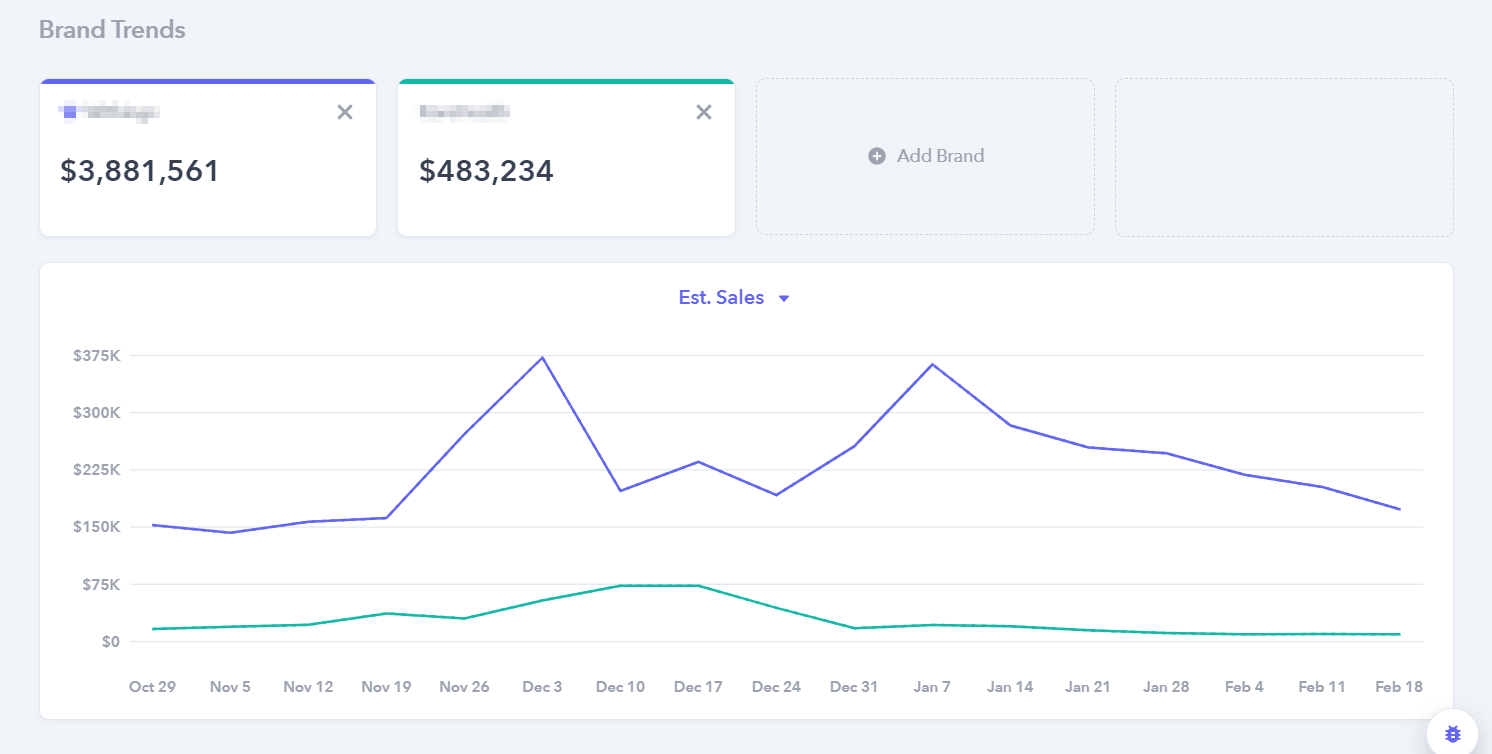
The chart above shows anonymized estimated sales data for two brands in this segment. The brand represented by the purple trendline has clearly been able to take advantage of the demand for digital body scales, as its sales in the week following New Year’s reach levels similar to BFCM. The brand represented by the teal trendline, however, captures none of this rebound in the market. This is clearly a missed opportunity.
Therefore, understanding market trends is useful for identifying opportunities associated with seasonality, and helping you have a proper marketing strategy in place before the season starts. Knowing how the market is trending will also guide budgeting decisions. If your marketing is growing by 20% then your budget should also be growing by 20%. The same holds true if the market is softening. The only way to know how the market is trending is to have strong marketing intelligence data. The kind that Prism puts at your fingertips.
To see how Prism can put market-aware advertising into your Amazon playbook, book a demo today.
Amazon competitor analysis FAQ
What is Amazon competitor analysis?
How do I run a competitor analysis on Amazon?
Which tool is used for Amazon competitor analysis?
How is business analytics used in Amazon?
What is competitive intelligence example?
To get started or learn more about how Perpetua can help you scale your Amazon Advertising business, contact us at hello@perpetua.io